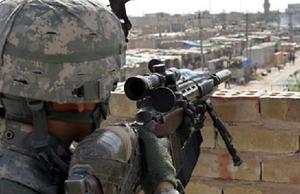DARPA aims to help U.S. Army snipers to, well, aim better
DARPA wants to help the U.S. Army’s snipers; in the works: programs aiming to give snipers the power to hit a target from 2,000 meters away in winds as high as forty miles per hour; making bullets that can change course in mid-air; and a stealth sniper scope that would make shooters all but invisible

Army sniper in position // Source: motivatedphotos.com
Earlier last month, a British Army sniper Corporal Craig Harrison broke the world’s record for superaccurate shooting, taking out a pair of Taliban machine gunners from a mile-and-a-half away. It was a one-in-a-million feat — one performed under “perfect” conditions, Harrison says: “no wind, mild weather, clear visibility.”
DARPA, the Pentagon’s intellectually restless research arm, is hoping to use lasers and advanced optical systems to make other snipers Harrison-accurate, even when the winds are howling. Olivia Koski writes that the agency is looking for fifteen ultraprecise sniper scopes to put in shooters’ hands by next year.
The One Shot program originally aimed to give snipers the power to hit a target from 2,000 meters away in winds as high as forty miles per hour. In the first phases of the 3-year-old program, shooters used prototype rifles dressed with lasers and fancy computer hardware to do damage from 1,100 meters away in 18-mile-an-hour winds. The scope-mounted lasers can “see” wind turbulence in the path of the bullet and feed the data to computers, enabling real-time calculation of — and compensation for — the wind-blown trajectory.
With initial demonstrations complete, the next step for One Shot is to make fifteen “field-testable prototype, observation, measurement, and ballistic calculation system[s], which enable [s]nipers to hit targets with the first round, under crosswind conditions, up to the maximum effective range,” DARPA says in its program announcement. Total cost: $7 million.
DARPA stresses that ”no alignment verification of the laser/crosswind optics to the spotting scope or calibration in-field should be required,” indicating that those early demos probably required a lot of tender loving care from the engineers who designed the systems. Lockheed Martin received $2 million to participate in the early phases of the program, and will presumably compete for the opportunity to make the rifles battle-ready.
What the agency really wants is a battle-ready system that does not require tricky in-field optical alignment and fiddling with lasers. Night and day accuracy also means that the laser, which is used to help calculate and subtract wind turbulence between the predator and his prey, can not be infrared. Enemies with night-vision goggles would see that from a mile away.
Koski notes that the program is slightly behind schedule. The original goal was to have production-ready scopes by fall of 2009. With luck, DARPA will have its new supersniper rifles by the fall of 2011.
